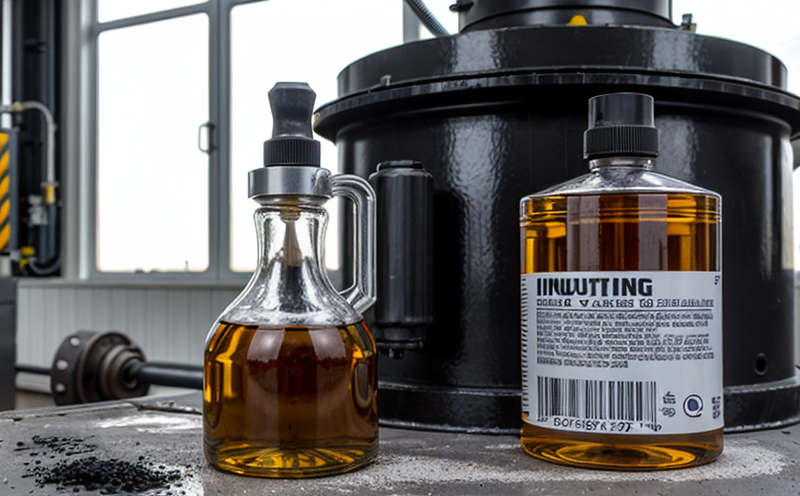ISO 3771 Nitration Content Testing of Lubricants
The ISO 3771 standard provides a method to determine the nitration content in lubricants, which is critical for assessing their stability and durability. In industrial environments where machinery operates under extreme conditions, understanding the nitration levels ensures that lubricant formulations are optimized to withstand oxidative stress. Nitration can lead to increased viscosity, reduced film strength, and decreased performance of the lubricant over time.
Our laboratory specializes in this precise testing procedure as part of our comprehensive suite of industrial oil and additive services. By adhering strictly to ISO 3771 guidelines, we ensure accurate and reliable results that are essential for quality assurance in manufacturing processes involving heavy machinery and complex equipment.
The nitration content test is particularly important for lubricants used in sectors such as automotive, aerospace, and industrial machinery where prolonged exposure to high temperatures and oxidative environments can accelerate degradation. Understanding these parameters allows engineers and procurement teams to select the most appropriate lubricant additives that will enhance performance while minimizing maintenance costs and downtime.
The testing process involves subjecting a sample of the lubricant to controlled oxidation conditions under specific temperature and time parameters defined by ISO 3771. This standard ensures consistency across different laboratories, making it easier for companies to compare results globally.
Once the test is complete, our team uses advanced analytical techniques such as gas chromatography-mass spectrometry (GC-MS) to quantify the nitration products formed during the oxidation process. The results provide a clear picture of the nitration content which can then be used by industry professionals to make informed decisions about lubricant formulations and usage.
The importance of this test cannot be overstated, especially in industries where equipment longevity is crucial for operational efficiency. By identifying early signs of degradation through nitration testing, companies can implement preventive maintenance strategies that extend the life of their machinery and reduce costly repairs or replacements.
| Test Parameters | Description |
|---|---|
| Temperature | The temperature at which the sample is oxidized, typically set between 98°C to 104°C for a period of 24 hours. |
| Oxygen Concentration | The concentration of oxygen used in the test atmosphere, usually maintained around 5%. |
| Sample Volume | The volume of lubricant sample required for testing, generally ranging from 10 to 20 mL depending on the type of lubricant. |
| GC-MS Instrumentation | The specific equipment used for analyzing nitration products in the sample post-oxidation. |
Our team of experts is committed to providing accurate and timely results, ensuring that our clients have access to actionable data they can use to improve their manufacturing processes. This service supports continuous improvement initiatives within organizations by offering insights into potential areas for enhancement or optimization related to lubricant performance.
Scope and Methodology
- The method involves the controlled oxidation of a representative sample of the lubricant at specified temperature and time conditions.
- A standard gas chromatography-mass spectrometry (GC-MS) analysis is performed on the oxidized sample to quantify nitration products.
- Results are reported according to ISO 3771, providing an internationally recognized measure of nitration content in lubricants.
The testing procedure outlined by ISO 3771 ensures that all laboratories following this standard achieve consistent results. This consistency is vital for industries relying on standardized metrics when comparing product performance across different suppliers or regions.
Our laboratory adheres strictly to these procedures, ensuring accuracy and reliability in every test conducted. The use of advanced analytical equipment like GC-MS allows us to provide precise quantification even at very low levels of nitration products.
Benefits
Improved Lubricant Stability: By understanding the nitration content, manufacturers can formulate lubricants that are more resistant to oxidative degradation, leading to longer product lifetimes and reduced maintenance costs.
Informed Decision-Making: Results from this test help quality managers and R&D engineers make informed decisions about lubricant formulations and usage strategies, optimizing performance across various applications.
Compliance Assurance: Adherence to ISO 3771 standards ensures that the testing process meets international regulatory requirements, providing peace of mind for companies operating in global markets.
Data-Driven Maintenance Strategies: Knowledge gained from nitration content tests enables procurement departments to select lubricants with appropriate additive packages tailored to specific operational environments.
These benefits extend beyond the immediate testing process, contributing to broader improvements in industrial processes and equipment reliability. By leveraging this information effectively, organizations can enhance overall efficiency while reducing resource consumption and environmental impact.
Environmental and Sustainability Contributions
The accurate determination of nitration content through ISO 3771 testing supports sustainable practices by enabling companies to choose lubricants that contribute less to environmental pollution. By minimizing the need for frequent replacements due to premature failure, these tests help reduce waste generation and associated disposal costs.
Furthermore, selecting stable lubricants reduces energy consumption during manufacturing processes because they require fewer reapplications or adjustments. This leads to lower carbon footprints and contributes positively towards corporate social responsibility goals.
In summary, ISO 3771 nitration content testing plays a crucial role in promoting sustainability within the industrial sector by supporting informed decision-making that balances economic efficiency with environmental responsibility.





